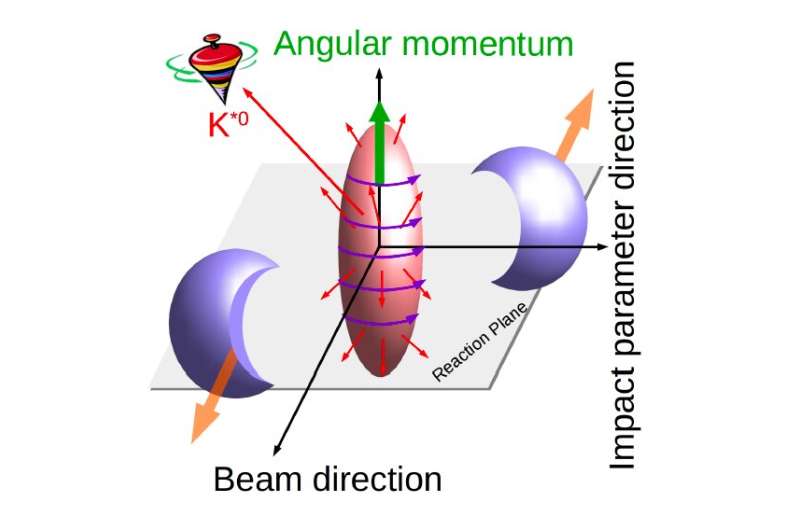August 10, 2020 feature
The first evidence of vector meson spin alignment in heavy-ion collisions

The ALICE collaboration is a large group of researchers from over 100 physics institutes worldwide that focuses on the study of quark-gluon plasma using data collected by the ALICE (A Large Ion Collider Experiment) detector. ALICE is a heavy-ion detector designed to examine the physics of strongly interacting matter at extreme energy densities, which is part of CERN's Large Hadron Collider (LHC) particle accelerator ring.
One of the key objectives of the ALICE experiment is to gain a better understanding of the properties of the quark-gluon plasma forms during high-energy collisions between heavy nuclei. The experiment has recently led to a number of interesting observations, outlined in a paper published in Physical Review Letters, which provide the first evidence of spin-orbital angular momentum interactions in relativistic heavy-ion collisions.
"When high-energy collisions between heavy nuclei are non-central (that is, not head-on), they impart on the formed plasma a very large angular momentum, estimated to be of the order of 107 ħ – equivalent to the order of 1021 revolutions per second," Luciano Musa, spokesperson for the ALICE collaboration, told Phys.org. "In simplified language, an extremely fast-spinning droplet of quarks and gluons is formed. Quarks, on the other hand, have a quantum-mechanical property called spin, which is analogous to a rotation around an axis."
The large angular momentum of the quark-gluon plasma formed in heavy-ion collisions can be, to some extent, transferred to individual quarks, aligning their spin directions. This quantum-mechanical effect, known as spin-orbit interaction, can also be observed in other instances, for example, between electrons, which also have spin and "rotate" around atomic nuclei.
"Spin-orbit interactions were previously studied using several colliding systems, but the large angular momentum of the plasma generated in collisions of lead nuclei at the LHC offered a unique opportunity to search for this fundamental quantum-mechanical effect in a system of deconfined quarks," Andrea Dainese, physics coordinator for the ALICE experiment, told Phys.org.

According to theoretical predictions, the spin-orbit interaction in quark-gluon plasma should align the spin of quarks, which have a spin quantum number of 1/2. The quarks from the plasma should then bind in pairs to form mesons with either spin 0 (i.e., scalar mesons), in which the two quarks have opposite spin orientation, or spin 1 (i.e., vector mesons), in which the two quarks have the same spin orientation.
Predictions suggest that the alignment of quark spins would then result in an alignment of vector meson spins. The ALICE Collaboration has observed this effect, gathering the first evidence of spin alignment in the decay products of what are known as neutral K* and φ (phi) vector mesons.
"We studied this spin alignment by measuring the angular distribution of the decay products of the vector mesons," Musa explained. "The strongest signal was seen for K* mesons and the confirmation that the signal is induced by spin alignment was obtained by means of the lack of a similar signal for neutral K mesons, which have spin 0. The present measurements are a step toward experimentally establishing spin-orbit interactions in the relativistic-QCD matter of the quark-gluon plasma."
The ALICE collaboration is the first research group to publish evidence that aligns with theoretical predictions of a large spin alignment of vector mesons in collisions of heavy nuclei. Their measurements are a significant achievement in the study of quark-gluon plasma, as they support the prediction that this plasma possesses an initial vorticity with unprecedentedly high angular momentum, which leads to quark spin alignment via spin-orbit interactions. Their work offers meaningful insight that could inform future studies investigating the properties of quark-gluon plasma.
The ALICE detector is currently undergoing a major upgrade, and in 2022, when CERN's LHC data collection campaigns will start again, it should be able to record Pb-Pb collision samples 50 times larger than those collected to date. This data will be far more precise than existing data and could thus lead to new fascinating discoveries about quark-gluon plasma.
"New studies with the charged K*, which has a magnetic moment seven times larger than that of neutral K*, may even allow for a direct observation of the effect of the very large magnetic field produced in the quark-gluon plasma by the fast rotation of electrically charged particles," Dainese said. "This magnetic field is estimated to be as large as 1014 Tesla, but vanishes in a time as short 10-23 seconds! In addition, it is also worth noting that the neutral K* spin alignment is surprisingly large compared to the polarization measured for Λ hyperons. Therefore, further studies of the effect with more precision will be very interesting, as well as of other effects that can relate to the same physics mechanisms from different angles."
More information: S. Acharya et al. Evidence of Spin-Orbital Angular Momentum Interactions in Relativistic Heavy-Ion Collisions, Physical Review Letters (2020). DOI: 10.1103/PhysRevLett.125.012301
Journal information: Physical Review Letters
© 2020 Science X Network



















